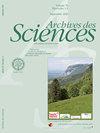From a Piece of Paper to Court Evidence: The Means Of Collection and Examination of Physical Documents in Ukrainian Criminal Justice
Q3 Multidisciplinary
引用次数: 0
Abstract
The purpose of this article is to outline criminal procedural and forensic means of collection and examination of physical documents in Ukrainian criminal justice. The linguistic analysis, formal-legal, formal-logical, modeling, forecasting methods, as well as the praxeological approach in forensic science are used. The authors argue that a document, as a material object, must be obtained in a manner permitted by law and examined using the necessary forensic means in order to acquire evidentiary status and be suitable for use in criminal proceedings. It was established that the procedural status of a document depends on its internal and external features. If the content of the document carries evidentiary information, it is considered written evidence; if such information is carried by its external (material) features, it is physical (real) evidence. Procedural means of collecting documents are defined by Art. 93 of the Criminal Procedure Code of Ukraine and differ for the parties to the proceedings. Preliminary, judicial and expert examination of documents is distinguished. The main stages of the preliminary examination of documents and the necessary technical means are described. It is emphasized that Ukrainian judges avoid using their own special knowledge when examining documents. Some features of the appointment of forensic examinations of documents and evaluation of their conclusions are highlighted. The perspective of the study of methods of using documents as evidence has been established.从一张纸到法庭证据:乌克兰刑事司法中收集和审查实物文件的手段
本文旨在概述乌克兰刑事司法中收集和检查实物文件的刑事诉讼和法医手段。本文使用了语言分析、形式-法律、形式-逻辑、建模、预测方法以及法医学中的实践论方法。作者认为,文件作为一种物质客体,必须以法律允许的方式获得,并使用必要的法医学手段进行检验,才能获得证据地位并适合在刑事诉讼中使用。根据规定,文件的诉讼地位取决于其内部和外部特征。如果文件内容包含证据信息,则被视为书面证据;如果外部(物质)特征包含此类信息,则被视为实物(真实)证据。收集文件的程序手段由《乌克兰刑事诉讼法典》第 93 条规定。乌克兰刑事诉讼法典》第 93 条规定了收集文件的程序手段,并根据诉讼各方的情况而有所不同。文件审查分为初步审查、司法审查和专家审查。对文件初步审查的主要阶段和必要的技术手段进行了说明。需要强调的是,乌克兰法官在审查文件时应避免使用自己的专业知识。强调了指定法医检查文件和评估其结论的一些特点。确定了研究使用文件作为证据的方法的角度。
本文章由计算机程序翻译,如有差异,请以英文原文为准。
求助全文
约1分钟内获得全文
求助全文
来源期刊

Archives Des Sciences
综合性期刊-综合性期刊
CiteScore
1.10
自引率
0.00%
发文量
0
审稿时长
1 months
期刊介绍:
Archives des Sciences est un journal scientifique multidisciplinaire et international. Les articles sont soumis à un comité
de lecture.
 求助内容:
求助内容: 应助结果提醒方式:
应助结果提醒方式:


